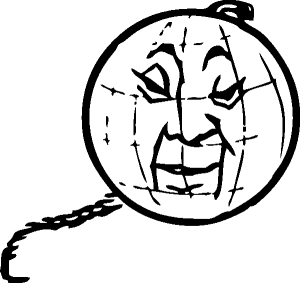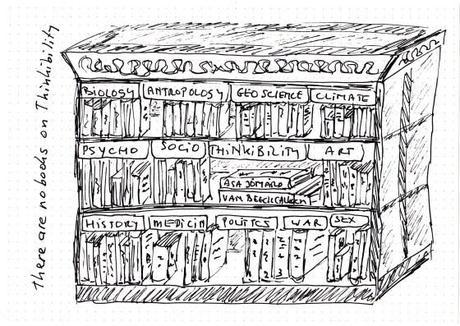As we last year noted, most end-of-the-year lists of books consists of books that have already been read by others and many of the lists consists of the same books. Often the lists consists of the books that have topped the sales lists during the year. The underlying message could be interpreted as “if you haven’t read these books, you must be a cultural savage, that you do not belong to the well informed elite and notbe able to go along in conversations”. Anyhow, this is a passive, following main-stream media approach.

Another, more active approach is to make ýour own list about Interesting Reading Areas (IRA), areas of your interest for development and knowledge acquisition. And then look for relevant writers, books and DVD’s belonging to that IRA.
We thought it would be nice to make a list of subjects or interesting areas for ourselves because we believe we would gain from such a list to help us preparing for the next parts of Thinkiblity – Thinking about Thinking, Creativity, Innovation and Design. Perhaps you may enjoy the list and will give you some directions for reading about Thinkibility. Just reading the titles would give you some new insides.
If you can help us to expand the list, please add a comment. Please note, we have not yet read the books! We invite you to make your own IRA’s and to find for each subject the interesting books and thinkers.
IRA: Is Western and Eastern Thinking different?

- The Art of Meditation by Matthieu Ricard, Sherab Chödzin Kohn, who also wrote about the relation between Western science and Eastern thinking in:
- The Monk and the Philosopher.
- The Geography of Thought: How Asians and Westerners Think Differently…and Why
- Trying Not to Try: The Art and Science of Spontaneity by Edward Slingerland
- Inside Peking University: Four Essays by Dr. Thorsten Pattberg
- Can Asians Think?: Understanding the Divide Between East and West by Kishore Mahbubani
- The East-West Dichotomy: The Conceptual Contrast Between Eastern and Western Cultures by Thorsten Pattberg
A related Interesting Reading Area is:
IRA How Language and Cuture create Thinking Patterns?
- Culture: Leading Scientists Explore Societies, Art, Power, and Technology Paperback by John Brockman
- Through the Language Glass: Why the World Looks Different in Other Languages by Guy Deutscher
- The Language Instinct: The New Science of Language and Mind
by Steven Pinker - Language: The Cultural Tool by Daniel Everett
IRA: How to improve Innovation ?
- Creative Execution: What Great Leaders Do to Unleash Bold Thinking and Innovation by Eric Beaudan
- Focus for The Fuzzy Front End of Product Development: The Idea Sheet Process by Eric G. Parker.
- Making Questions Work: A Guide to How and What to Ask for Facilitators, Consultants, Managers, Coaches, and Educators
by Dorothy Strachan - Gamestorming: A Playbook for Innovators, Rulebreakers, and Changemakers by Dave Gray, Sunni Brown, James Macanufo
- Sudden Genius: The Gradual Path to Creative Breakthroughs
by Andrew Robinson - Creativity, Inc.: Overcoming the Unseen Forces That Stand in the Way of True Inspiration by Ed Catmull and Amy Wallace
IRA: How does bad ideas spread?
To begin with how good ideas are spread:
- Social Physics: The Lessons from a New Science by Alex Pentland.
- Made to Stick: Why Some Ideas Survive and Others Die by Chip Heath (Author), Dan Heath
About the spreading of bad ideas: by Ben Goldacre
- Bad Science
- Bad Science: Quacks, Hacks, and Big Pharma Flacks
- The News: A User’s Manual by Alain De Botton
IRA: Overcoming Mechanistic Reasoning
The most remarkable feature of our thinking is it mechanistic nature. It is linear. It does not take into account that there might be a feedback effect.

That a cause produces an effect, what will in turn effect the cause. We still continue thinking “Newtonian” in our daily practice. Overcoming linear thinking might be found in system dynamics, complex networks,social psychology and game theory.
- Jane Austen, Game Theorist by Michael Suk-Young Chwe
- The Art of Strategy: A Game Theorist’s Guide to Success in Business and Life by Avinash K. Dixit (Author), Barry J. Nalebuff
IRA How to improve visualization skills radically?
- Visual Thinking Strategies: Using Art to Deepen Learning Across School Disciplines by Philip Yenawine

- LEGO Architecture Studio
- Visual Meetings: How Graphics, Sticky Notes and Idea Mapping Can Transform Group Productivity by David Sibbet
- Steal Like an Artist: 10 Things Nobody Told You About Being Creative by Austin Kleon (Author)
IRA: What is Design Thinking really?
- Change by Design: How Design Thinking Transforms Organizations and Inspires Innovation by Tim Brown
- Design Thinking for Strategic Innovation: What They Can’t Teach You at Business or Design School by Idris Mootee
- Essentialism: The Disciplined Pursuit of Less by Greg McKeown
- Insanely Simple: The Obsession That Drives Apple’s Success
by Ken Segall
IRA: What is Thinkibility?
Thinkibility is a kind of agility in thinking. It is like the skill someone possesses when he she is talented, f.e. in football. However, there are no books about Thinkibility (at least for as part V of our book is not yet published).

However, some books are hinting at it:
- The Art of Non-Conformity: Set Your Own Rules, Live the Life You Want, and Change the World by Chris Guillebeau
- Drunk Tank Pink: And Other Unexpected Forces that Shape How We Think, Feel, and Behave by Adam Alter
- Mastermind: How to Think Like Sherlock Holmes
by Maria Konnikova - Mastery (in thinking) by Robert Greene What did Charles Darwin, middling schoolboy and underachieving second son, do to become one of the earliest and greatest naturalists the world has known? What were the similar choices made by Mozart and by Caesar Rodriguez, the U.S. Air Force’s last ace fighter pilot? And more?
- Thinking Beyond Limitation: The Pathway To Infinite Intelligence And Possibilities by Massimo Barbato
- The Art of Thinking Clearly by Rolf Dobelli
- How We Reason by Philip Johnson-Laird
Happy readings in 2015!

